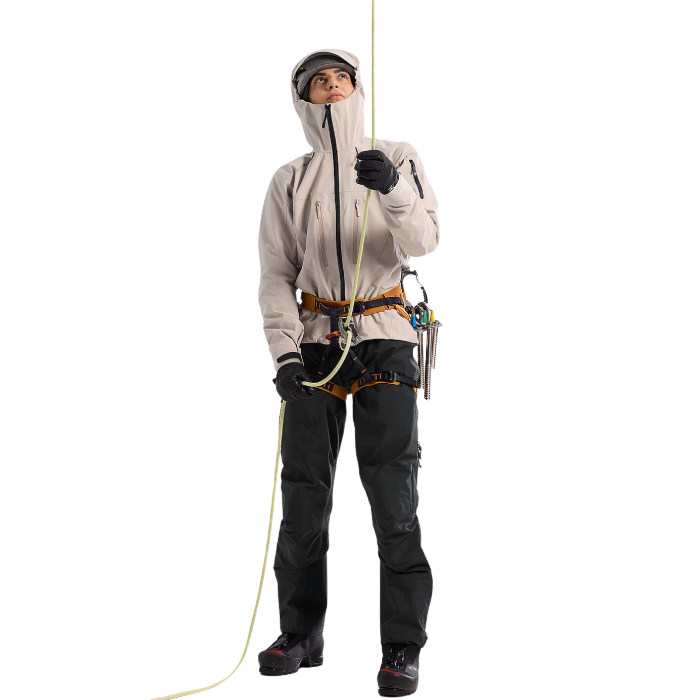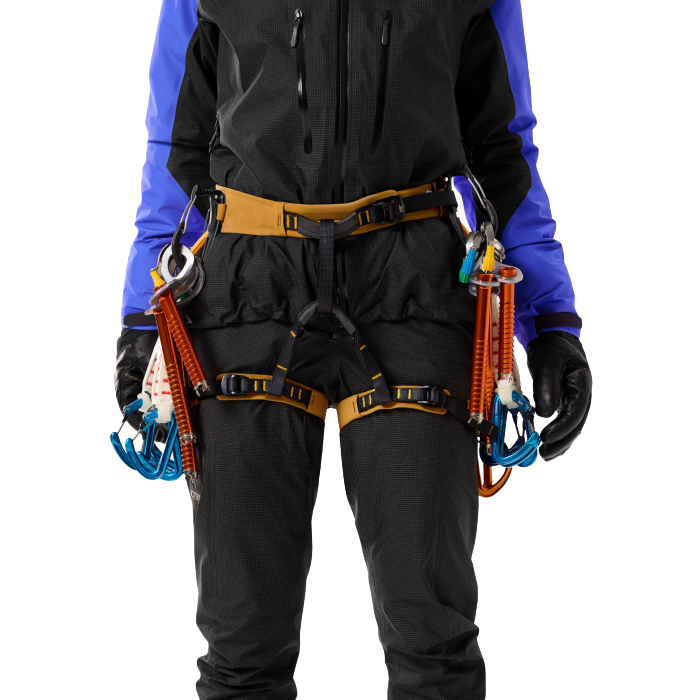Size chart of Arc'teryx Harnesses. Men, women and unisex.
AR 385a
Description
Versatile women’s harness for sport, trad, alpine, mixed or ice climbing. AR: All Round.
You climb to go beyond limits, discover new places, and experience different environments. Designed just for women, the AR-385a Harness delivers elite performance across the climbing’s entire spectrum – rock, ice, trad, sport, alpine and mixed. Adjustable leg loops create a precise fit, our Warp Strength Technology™ comfortably distributes weight across the swami, and softer edges eliminate cutting and binding. Durable, compact, supple and light, the AR-385a elevates performance, comfort and versatility.
This product contains PFAS chemicals, but is exempt from the January 2025 legislative deadline. Arc’teryx is guided by science and committed to transitioning to PFAS-free chemistry across our line over the coming years.
Customer service tips: Please note that due to health & safety considerations harnesses that have been purchased cannot be returned.
-
Stretchy mesh storage bag
-
Self locking buckles
-
Adjustable leg loops enable a precision fit with varying layers
-
Wear safety markers on belay loop and tie-in points
-
Four ice clipper slots
-
Stainless steel quick hook on the rear leg elastic permits using the bathroom without taking off your harness
-
Women's specific fit
-
Warp Strength Technology (WST™) minimizes bulk and equally distributes pressure from edge to edge for a more comfortable fit
-
Contains materials that meet the bluesign® criteria
-
Primary fabric - bluesign® approved material
-
PFAS Warning - Made with PFAS (Per- and polyfluoroalkyl substances) chemicals
Retail price
When you click a link below and then checkout online, no matter what you buy (climbing gear or not), we get a small commission that helps us keep this site up-to-date. Thanks!

Weight (g)  WeightIn grams, the weight, as stated by the manufacturer/brand. If there are differences in weight (due to multiple sizes or optional accessories) we'll list them here. The default weight is the middle-most size, often this is size M. | 385 g |
| Fit | Women |
| Sizes | XS, S, M, L, XL, XXL |
Gear Loops  Number of Gear LoopsGear loops are used to hold gear (quickdraws, cams, etc) onto your harness. 4 gear loops is most common. 
0 - 1 Gear LoopsMost often on full body harnesses or guide/gym style harnesses. 2-3 Gear LoopsMostly found on lighter harnesses made for [ski] mountaineering or high-end sport climbing where weight is a high priority. 4 - 5 Gear LoopsThe standard/most common number for climbing harnesses. Perfect for sport and trad. More Than 6 Gear LoopsDesigned for long multi-pitch and big wall climbing, found on harnesses made to hold the maximum amount of gear. Worth ConsideringOccasionally, the number of gear loops will change on a harness model depending on the size. There could be 7 gear loops for the med/large but only 5 gear loops for the xsmall/small. In this case we list the highest number for the filters, and then write an explanation on the product page like, “Size S/XS can only fit 5 gear loops.” | 5 Gear loops |
Ice Clip Slots  Ice Clip SlotIce clipper slots are made to fit a carabiner that holds ice screws. These slots are generally only used by ice climbers but there is no disadvantage to having them on your harness. 
Less than 40% of harnesses will have ice clipper slots. And those harnesses will usually have 2 or 4 slots, often located next to, or between, the gear loops. | Yes, 4 |
| Belay / Tie-In | One Loop |
| Waist Buckle Type | Quick Adjust |
| Leg Buckle Type | Quick Adjust |
| Drop Seat | Yes |
Haul Loop  Haul LoopTrad climbers often look for a haul loop as they're intended to haul a rope (second line) or pack (while you climb the chimney). 
A haul loop can also hold shoes or other accessories. Although not the intended use, it is also commonly used to hold a chalk bag. | No |
| Certification | |
| Size Chart | XS
Waist : 64-69 cm / 25-27 in Legs : 52-56 cm / 20.5-22 in S Waist : 69-74 cm / 27-29 in Legs : 55-59 cm / 21.5-23 in M Waist : 74-81 cm / 29-32 in Legs : 58-62 cm / 23-24.5 in L Waist : 82-91 cm / 32.5-36 in Legs : 62-66 cm / 24.5-26 in XL (will fit the lower range of XXL) Waist : 92-100 cm / 36-39.5 in Legs : 67-71 cm / 26.5-28 in |
No reviews yet.
The new AR-385a from Arc'teryx is an impressive piece of engineering, and you're sure to get many compliments and questions about its design when wearing it. While we really liked many aspects of this harness, it didn't quite measure up to some of the other models that we tested. It's designed to be an all-around do-it-all harness, and while it does have all the necessary components to fit that slot, we just couldn't get past how uncomfortable the leg loops were while hanging. We found the all-around Camp Supernova much nicer to hang in, and it cost a lot less than this harness to boot. That said, if you're looking for a compact option for alpine missions, then this is still a good pick.
If you know of a good product video that should be here, let us know, and we'll put it up.
If you're looking for gear videos in general, check out our Vimeo and YouTube channels to see the newest gear.
How to use Arc'teryx harness, warnings, inspection, lifespan and care with instructional pictures
A pictoral representation of UIAA-105 and EN-12277 standards for harnesses.
The UIAA equipment standard provides a baseline for equipment performance in a test lab under controlled conditions on new equipment. Although these test conditions are relevant to the conditions encountered climbing, conditions encountered at the crags and the condition of the equipment are equally important. This recommendation from the UIAA member federation The British Mountaineering Council (BMC) provides vital equipment information that is NOT explicitly addressed in the standard, particularly failure modes of the equipment and recommendations for the use, inspection, maintenance, and retirement of equipment.














































